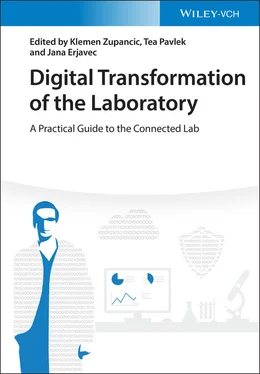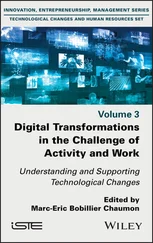Data will remain a key element of the workflow. Being able to send data to quantum computers and to retrieve the outputs from them quickly will help to influence the next experiment. However, with the rarity of quantum computing, careful planning of the holistic workflow of the data and compute will be needed to ensure best efficiency of location and data pipelines. There will be an even greater need to maintain the large volumes of data necessary for the calculations “close” to the compute power to avoid large delays in moving data around. The timelines for the impact of quantum computing remain uncertain as the jump from research to production ready is hard to judge. Not every LotF will have a quantum compute facility nearby, but in time they will be able to access this accelerator technology more readily to support their key processes. Unarguably, quantum computing will be a very exciting area for life science and will create a whole new era of scientific exploration.
1.2.5.3 Impact of AI and ML
Even with all the hype around it, AI and its subtypes, e.g. ML, will undoubtedly reshape the R&D sector and have a huge impact on the LotF [85, 86]. Many see AI as the competitive edge which will accelerate products to market, or improve patient outcomes and care, and drive cost efficiencies. As a consequence, there now exists a major talent war as organizations seek to attract the best candidates.
With the rise of AI within life sciences and health care, it has become obvious that a key blocker to success is not the maturity of the AI tools and techniques but access to data in sufficient volume and quality for the AI and ML methods to operate meaningfully. The phrase “no data, no AI/ML” is a signature of the current challenge, with much of the accessible data having been created without due care and attention to reproducibility and the FAIR principles, which are only now driving business improvement in data collection and annotation. Depending on the AI/ML model being developed, having access to a broad cohort of data from across the particular domain will be critical to ensure the necessary diversity, edge cases, and breadth. It is this which will make the analyses successful and be broadly applicable.
The LotF will be both the source of new data to drive new insights from the AI predictive workflows and a beneficiary of the AI outputs which can augment the scientists' work. As mentioned earlier, voice activation, AR, and other assisted technologies all use elements of AI to support the user, whether as chatbots or more sophisticated experiment assistants for the scientist. For example, an automated AI assistant needs to be trained on data to enhance its capability. In time it learns from the human interactions, and this helps to improve its responses and output. Even without AI though, the drive for higher quality and more abundant data remains critical.
The role of AI in generating new ideas fits perhaps most cleanly in the in silico predictive, “design” workflows that have always existed in science. However, AI has the potential to produce new ideas not previously explored or considered by humans. For the lab scientist, the role of AI will be multivariate, from supporting the initial idea to be explored, through experimental design and execution, through to finally how the data is captured and the results analyzed. AI will augment the scientists' capability during their time in the lab as well as provide new insights to guide the best outcome from the experiment. For some, the likely benefit will be decreased experiment cycle times, allowing a better outcome in a fixed time period, for others it will be quicker decision‐making through linking the virtual with the physical. Complementary to this, using AI and robotics appropriately in the LotF will allow scientists to focus on the practical things that these technologies do not support well. This will make the fewer humans in the LotF more efficient and productive. Other “softer,” less technical factors will also become increasingly important going forward; these include the broader ethics of AI and the possible regulatory implications of using AI for R&D decisions. The clamor to solve these issues will become louder as the potential and positive impact of AI on life science and health care is demonstrated, validated through application of the AI models to real decision‐making.
Any attempt to predict what will be the big new, “hottest” areas of science is fraught with risk. When one overlays, for the purpose of this book, how those “hot new science areas” might impact the experiments and activities going on in the lab of the future, combined with how that LotF might look physically, then the chances of this section being at best, a bit “off” and at worst plain wrong increase rather dramatically! Nevertheless, even with this “caveat emptor,” we feel that in this forward‐looking section, it is important to call out a few of the new scientific areas [87] which we personally feel are worth watching for how they might impact the LotF. In keeping with the broad scope of this book we have concentrated more on the likely scientific developments in (i) the health care and (ii) the life sciences domains, but we have also picked out a small number of examples in (iii) other scientific areas.
1.2.6.1 New Science in Health Care
The biggest drive recently in health care, for both diagnosis and treatment, has been the move away from more population‐based approaches toward a much more personalized focus. This has been made possible by the huge advancements in gene and genome‐based technologies. Advances in gene and whole‐genome sequencing will continue to assist better diagnosis, with sequencing times and costs reducing dramatically, and accuracy and quality rising significantly. These advances will make the protocol‐driven labs more prevalent, more efficient, and more cost‐effective. The development of better treatments based on gene expression manipulation and gene editing (e.g. CRISPR) [4]) as well as pure gene therapy [88] will continue apace. Diseases that will benefit from such developments will include many inheritable conditions such as Huntington's chorea and cystic fibrosis, as well as many cancers.
On the whole cell front, improvements in chimeric antigen receptor T‐cell (CAR‐T) [89] treatments to “supercharge” a patient's own immune system will mushroom. Individual CAR‐T therapies to fight cancers more widely, not just leukemia and lymphoma but also more difficult‐to‐treat infections (e.g. tuberculosis [90] and some viruses), will become more widespread and cost‐effective [91]. Other, more traditionally based approaches to the treatment of diseases, such as vaccines to combat certain viruses (e.g. influenza and novel corona viruses) and some cancers (e.g. cervical cancer), as well as stem cell therapy [92] will continue to thrive. New, more effective vaccine approaches to a greater range of cancers and novel viruses will be developed more quickly than before. Better understanding of some long‐standing diseases, for example in the cardiovascular arena, will demonstrate infectious components [93], and these too will become susceptible to vaccine approaches.
Building on the infectious agent theme, research into novel approaches to treat bacterial and viral infections will continue, although probably mostly in academic and charitable trust‐funded labs. Approaches such as phage‐based treatment for bacterial infections will become more of a focus as traditional small molecule‐based strategies are met with evermore intractable and resistant bacteria [94]. Supercharged immunological approaches to bacterial infection will also be a focus for research.
The growth of such novel therapeutics as CAR‐T, alongside other whole cell‐based approaches and non‐small molecule agents, will complement the ever‐expanding set of large‐molecule therapies. The use of these so‐called biopharmaceuticals or biologics has become more widespread in the past decade and will continue to grow. Similarly, the research, development, and manufacture of antibodies [95], modified RNA [96], peptides [97], conjugates, proteolysis targeting chimera agents (PROTACS) [98], antisense oligonucleotides, and other therapeutic macromolecules will continue to expand rapidly. While in vitro activity of such agents can often be demonstrated relatively clearly, they present a major challenge when it comes to in vivo efficacy. The development of novel formulation and drug delivery systems to enable effective administration of these twenty‐first century therapeutics will become a major area of scientific investigation.
Читать дальше











